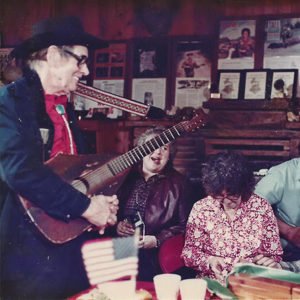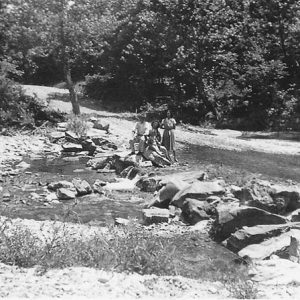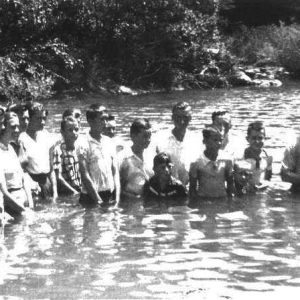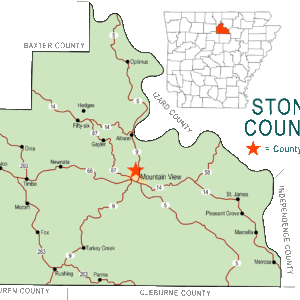calsfoundation@cals.org
Timbo (Stone County)
Originally part of the Locust Grove community, Timbo is located on Highway 66 thirteen miles west of Mountain View, the county seat of Stone County. During the Civil War, it served as one of the induction centers for Searcy County. At the time, the area was also a hotbed of wartime dissention, with the Arkansas Peace Society active in the region. Timbo is today perhaps most well known for its association with musician Jimmy Driftwood.
The pioneers to the area first settled in Campbell, today almost a ghost town, in Searcy County, sixteen miles southwest of Timbo. The Campbell brothers—Wash, John, James, Alex, and David—along with their families from Tennessee, were the first white settlers in the area, having followed the Indian trial from Batesville (Independence County) in 1836. The Morrison family, which became a leading family of the community, was among the other pioneers of the region. Thomas Morrison from Johnson County, Illinois, settled his family along upper Sylamore Creek in 1842 and eventually opened a general store on his farm. He had taken a keen interest in politics and had joined the Whig Party while in Illinois. Another pioneer family was the Maloy family. John Maloy, emigrating from Tyrone, Ireland, settled in the region in the early 1840s.
Much of the violence on the homefront during the Civil War in what was then Searcy County was related to lawlessness and banditry, as well as the suppression of the Arkansas Peace Society, which formed in the early days of secession. Although the leaders of the society claimed primarily to be against secession and war in general, the newly formed Confederate government of Arkansas looked upon the members as traitors. As many members as could be caught were rounded up by Colonel Samuel Leslie, head of the Searcy County militia. In December 1861, seventy-eight men were chained together and marched from Burrowville—present-day Marshall (Searcy County)—to Little Rock (Pulaski County). (The chain gang episode inspired Jimmy Driftwood to write “He Had a Long Chain On,” covered by popular recording artists Peter, Paul, and Mary in 1963.) Outlaw Bill Dark terrorized the Searcy County region and hid out in Dark Holler (a.k.a. Dark Hollar) at Locust Grove until he was killed by fifteen-year old Jim Berry in early 1863. Berry was a known associate of Union sympathizers. It is now believed that Bill Dark was being paid by the Confederate governor of Arkansas, Henry Massie Rector, to track down and eliminate the remaining Peace Society associates. Many in the region used the mask of allegiance to settle old scores.
In July 1864, while the Morrison brothers were away fighting in the Civil War, Thomas Morrison, who was in his sixties, was at home with his wife, Polly, and their youngest child, Sarah Jane (age thirteen). A group of irregulars galloped into the Morrison yard, having heard that gold was hidden on the Morrison farm. They tied Morrison up and forced him to walk around in circles in the front yard with no water, trying to make him tell where the gold was hidden, until he collapsed and died from exhaustion. His wife and daughter buried his body near the front yard. When the sons returned from the war, they tracked down the jayhawkers and avenged their father’s murder. The road in Timbo leading to the place where his body is believed to be buried has been named the Thomas C. Morrison Road.
Following the Civil War, farming and raising livestock dominated the economy, as they still do in the twenty-first century. A two-story building called the Hall was the only place of note in what would become Timbo. The second floor housed the Masonic lodge, while the first floor was used as a general merchandise store owned and operated by Colonel Tandy Young Casey, whose brother-in-law was Dr. Joseph Marion Wolf, a medical doctor who practiced in the Hall. Wolf and Colonel Casey’s wife, Malinda, were the children of Major Jacob Wolf. Dr. Wolf left Timbo for Texas in 1891, and the young doctor who took over his practice, along with a friend, were later convicted for colluding with the infamous Bullfrog Valley Gang of Pope County for smuggling and passing counterfeit paper money.
Before the Timbo post office opened in 1886, the Blue Mountain post office served the area from 1837 to 1886. The first post office at what is now Timbo opened in 1886 with Joseph Lan Maloy appointed the first postmaster. Joseph Maloy had a brother named James Maloy, whom everyone called “Jimbo.” Jimbo Maloy was appointed postmaster of Timbo in 1888. It was decided to use his nickname for the name of the new post office, but a postal bureaucrat mistook the “J” for a “T,” and so Timbo was born. The current Timbo post office is located near the intersection of Highway 66 and Happy Hollow Road.
In the 1880s, the Reverend Jacob King, who lived in Timbo, founded the Bethany Missionary Baptist Church in nearby Onia (Stone County); it is still active in the twenty-first century. He was also a teacher, farmer, and legislator and had served in the Confederate army in North Carolina.
Timbo’s main claim to fame is the role it played in the folk music revival in the late 1950s, primarily through James Morris (who later took the name of Jimmy Driftwood). Folklorist Alan Lomax visited Timbo to record Driftwood’s father, Neil Morris, and to record and interview others relating to the rich folk heritage of the area. When RCA Records heard Neil Morris’s son James play “The Battle of New Orleans,” they contracted with him to record it, thus launching his career as a songwriter and musician. Driftwood later aided in the establishment of the Ozark Folk Center State Park in Mountain View.
One of the most beautiful natural features of Timbo is Roasting Ear Creek, pronounced “Roshneer” by locals. It supposedly got its name from a long-ago flood that washed roasting ears of corn downstream. The creek is noted for hosting fishing, swimming, and baptisms. Local minister Earl Marvin Gammill reported that he had conducted more baptisms than he could remember in the creek. According to his daughter, Nola Gammill Morrison, Gammill was a Baptist pastor in Stone and Searcy counties in Arkansas and also in Okemah, Oklahoma.
The old Roasting Ear School and church still stands in a secluded location near the spring source for the creek. In February 1940, a dispute concerning student discipline erupted into an argument just outside the schoolhouse door one night during singing lessons. Two men, who were cousins, were killed in the scuffle. The building is today used for activities such as reunions and revivals.
Timbo had its own elementary and high school until 2004 when it was consolidated with the Mountain View School District. Several churches are active in Timbo, with the Blue Mountain Missionary Baptist Church being the oldest still active.
For additional information:
Clemons, Veda Mae, ed. Searcy County, Arkansas: A History of Searcy County, Arkansas. Marshall, AR: Searcy County Retired Teachers Association, 1987.
Davis, Michael A. “The Legend of Bill Dark: Guerrilla Warfare, Oral History and the Unmaking of an Arkansas Bushwhacker.” Arkansas Historical Quarterly 58 (Winter 1999): 414–429.
Johnston, James J. “Arkansas’ 1861 Peace Society.” Arkansas Family Historian 29 (March 1991): 13–29.
———. Shootin’s, Obituaries, Politics, Emigratin’, Socializin’, Commercializin’, and the Press: News Items from and about Searcy County, Arkansas, 1866–1901. Fayetteville, AR: Searcy County Publications, 1991.
Lucas, Ann Davenport. “The Music of Jimmy Driftwood.” Mid-America Folklore 15 (Spring 1987): 27–41.
Kenneth Rorie
Van Buren, Arkansas
 Blue Mountain
Blue Mountain  Blue Mountain School
Blue Mountain School  Jimmy Driftwood at Home
Jimmy Driftwood at Home  North Sylamore Creek
North Sylamore Creek  Rackensack Album
Rackensack Album  Roasting Ear Creek Baptism
Roasting Ear Creek Baptism  Stone County Map
Stone County Map  Joseph Marion Wolf
Joseph Marion Wolf 




The Blue Mountain School in Timbo really caught my attention. I am the great-great-grandson of John Cartwright, who started the Cartwright Mill. I also know that his son James T. Cartwright and his family of seven kids, including my grandfather Charles (Omar) Cartwright, were living in Timbo in 1910. I think it’s a good bet my grandfather is one of the kids in the photo.